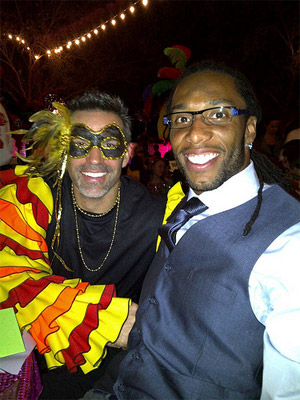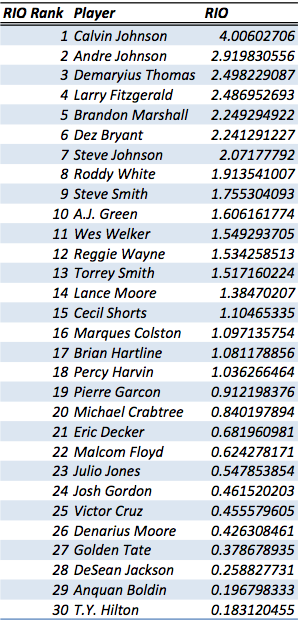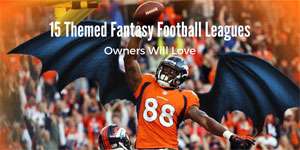While we have control over what kind of toppings we have on our pizza and what kind of beer we drink—hopefully you enjoy strong IPAs, otherwise I have very little respect for you—there are many, more important structures in our lives that we have no control over: the laws of the cities we live in, natural disasters, Raheem Moore blowing his coverage and allowing a 70-yard touchdown pass on a third-and-three with 44 seconds left in last year’s AFC playoffs; You get the point (and the clue that I am a Broncos fan).
There is a lot that we have no control over, and the more we think we can influence, the more we will drive ourselves crazy when something we think we can control goes berserk. In the same way that we have very little control over the course our lives take, the same may be true for NFL/Fantasy wide receivers and their ability to have control over their final numbers.
If we focus on what receivers control themselves, we can adequately assess a receiver’s performance, and find a way to numerically judge their ability independent of their quarterback and offense.
Take Larry Fitzgerald. Beyond the fact that Fitzgerald did not have a quarterback that could get the ball within five yards of his target area all of 2012, the Cardinals’ offensive line was so imbued with pass rushers, that the teams quarterback at a given moment rarely had the time to set his feet and make an accurate throw. Not only did Fitzgerald have no control over the talent of the quarterback who attempted to pass him the ball, he also had no control over the offensive line that the quarterback depended on for protection.
When it comes to wide receivers, a lot needs to go right for their statistics to show production. So, what can Fantasy wide receivers control?
(For those sabermetricians out there, this buildup probably sounds very familiar to you, and you can skip ahead a few paragraphs to where I diagram the formula and show the results). Plain and simple, receivers can control how often they get open down field. That’s it.

This picture is too amazing not to include in the article. Photo Credit: Player Perspective.
In an effort to develop a formula that divulges the true quality of performance for Fantasy wide receivers, I developed Receiving Independent Offense (RIO).
RIO puts a numerical value on a receiver’s ability to consistently get open down field. The sabermatricians that are still reading are either rolling their eyes or are very interested. I told you to skip ahead! You already know where this is headed!
In order to judge a receiver’s ability independent of their quarterback and offense, I looked to combine the two statistics that a receiver has complete control over: yards-per-target and targets-per-game. RIO weights yards-per-target—how far down field receivers get open—with targets-per-game—how often they get open down field.
RIO answers the question, “if every wide receiver had played on the same offense and had the same quarterback, who would be the best reciever?”
Formula:

*League AVG and Standard Deviation indicates the average and standard deviation of a given population. For our purposes, the population calculated the RIO for the top 69 Fantasy wide receivers from 2012 (I swear it is a coincidence that it turned out to be 69 players).
Top 20 Fantasy Wide Receivers RIO Scores:

What is interesting is that this list comprises the leagues top wide receivers and a lot of wide receivers who, I am sure most people would conclude are talented, but play on an offense whose quarterback or offensive line, or some combination of both, are less than average.
Now that we have seen the players that had the best RIO for 2012, let’s look at the players whose RIO score differs the most in a positive direction from their actually Fantasy rank.
For this list I subtracted a receiver’s 2012 Fantasy rank — I used FFtoday.com’s scoring system — from their 2012 RIO rank:

Well, that looks about right. It doesn’t take a football expert to know that Fitzgerald had a lousy quarterback last year, or that Pierre Garcon was a stud when he played. But, it is interesting to see how well they played in comparison to their final Fantasy totals.
The goal of RIO is to unearth a wide receiver’s true performance, stripped from the influence of their quarterback and offense. This is where RIO can be useful for Fantasy purposes. If Fantasy wide receivers have underperformed their RIO number, it is most likely because of a deficiency with their quarterback or offense, and with improvements to a team’s quarterback or offense in general, a wide receiver’s numbers should regress towards their RIO number.
Fitzgerald did not become an awful wide receiver last year, but his quarterback and offensive line sure were bad. RIO shows that Larry Fitzgerald was, well, still Larry Fitzgerald, and now, with a competent quarterback under center, Fitzgerald will look to show us how good he still is.
*I would like to say that this article would not exist without Voros McCracken and his discovery and work on DIPS theory.
Devon Jordan is obsessed with statistical analysis, non-fiction literature, and electronic music. If you enjoyed him here, reading about these predictive starting pitcher rankings, follow him on Twitter @devinjjordan.


























